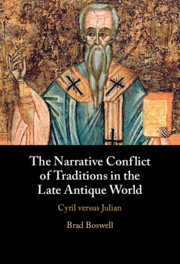Refine search
Actions for selected content:
3388592 results
BLOWN-UP BOUNDARIES ASSOCIATED WITH AMPLE CONES OF K3 SURFACES
- Part of
-
- Journal:
- Nagoya Mathematical Journal , First View
- Published online by Cambridge University Press:
- 23 September 2025, pp. 1-30
-
- Article
- Export citation
A viscous continuum theory of sea ice motion based on stochastic floe dynamics – CORRIGENDUM
-
- Journal:
- Journal of Fluid Mechanics / Volume 1019 / 25 September 2025
- Published online by Cambridge University Press:
- 23 September 2025, E1
-
- Article
-
- You have access
- Open access
- HTML
- Export citation
Ice shelf evolution combining flow, flexure, and fracture
-
- Journal:
- Journal of Glaciology / Accepted manuscript
- Published online by Cambridge University Press:
- 23 September 2025, pp. 1-31
-
- Article
-
- You have access
- Open access
- Export citation
“How I would like to forget”: Lived experiences of traumatic and stressful life events among older adults in Peru
-
- Journal:
- Cambridge Prisms: Global Mental Health / Volume 12 / 2025
- Published online by Cambridge University Press:
- 23 September 2025, e108
-
- Article
-
- You have access
- Open access
- HTML
- Export citation
Factors that influence the use of direct access to allied health professionals in the Netherlands
-
- Journal:
- Primary Health Care Research & Development / Volume 26 / 2025
- Published online by Cambridge University Press:
- 23 September 2025, e80
-
- Article
-
- You have access
- Open access
- HTML
- Export citation
In Memoriam: Fr. Francisco Morales Valerio
-
- Journal:
- The Americas , First View
- Published online by Cambridge University Press:
- 23 September 2025, pp. 1-5
-
- Article
-
- You have access
- HTML
- Export citation
Re-evaluating Heterogeneity in Evidence Synthesis
-
- Journal:
- Philosophy of Science / Accepted manuscript
- Published online by Cambridge University Press:
- 23 September 2025, pp. 1-28
-
- Article
-
- You have access
- Export citation
Impact of small-scale obscuration, surface roughness and reflectivity fluctuations of optical elements on the temporal contrast of a femtosecond pulse
-
- Journal:
- High Power Laser Science and Engineering / Accepted manuscript
- Published online by Cambridge University Press:
- 23 September 2025, pp. 1-19
-
- Article
-
- You have access
- Open access
- Export citation
Assessing physiological and behavioural impacts of unmanned aerial vehicles on chinstrap penguin chicks: an experimental approach
-
- Journal:
- Antarctic Science , First View
- Published online by Cambridge University Press:
- 23 September 2025, pp. 1-9
-
- Article
-
- You have access
- Open access
- HTML
- Export citation
ERW volume 33 issue S1 Cover and Front matter
-
- Journal:
- European Review / Volume 33 / Issue S1 / March 2025
- Published online by Cambridge University Press:
- 23 September 2025, pp. f1-f3
-
- Article
-
- You have access
- Export citation
Correlation between fluid deformation and density distortions in stably stratified shear layers
-
- Journal:
- Journal of Fluid Mechanics / Volume 1016 / 10 August 2025
- Published online by Cambridge University Press:
- 23 September 2025, A62
-
- Article
-
- You have access
- Open access
- HTML
- Export citation
Wondering about the Impossible: On the Semantics of Counterpossibles by Maciej Sendłak, Synthese Library, Vol. 487, Springer International Publishing, 2024, 192pp., £99.99 (hbk) ISBN: 978-3-031-65360-5 doi: 10.1007/978-3-031-65361-2
-
- Journal:
- Philosophy , First View
- Published online by Cambridge University Press:
- 23 September 2025, pp. 1-6
-
- Article
- Export citation
Precipitation prediction over the upper Indus Basin from large-scale circulation patterns using Gaussian processes
-
- Journal:
- Environmental Data Science / Volume 4 / 2025
- Published online by Cambridge University Press:
- 23 September 2025, e46
-
- Article
-
- You have access
- Open access
- HTML
- Export citation

Re-Imagining Supply Chain Management
- Uncovering the Hidden Trade-offs in the Digital Age
-
- Published online:
- 22 September 2025
- Print publication:
- 09 October 2025

The Narrative Conflict of Traditions in the Late Antique World
- Cyril versus Julian
-
- Published online:
- 22 September 2025
- Print publication:
- 09 October 2025

Modelling Evolution
-
- Published online:
- 22 September 2025
- Print publication:
- 16 October 2025
-
- Element
- Export citation

Plato's Unwritten Doctrines
-
- Published online:
- 22 September 2025
- Print publication:
- 16 October 2025
-
- Element
- Export citation
Uncinaria stenocephala (northern hookworm) is the major endoparasite in dogs from private dog shelters in the Balkans: presence of benzimidazole susceptible isotype-1 β-tubulin alleles
-
- Journal:
- Parasitology / Accepted manuscript
- Published online by Cambridge University Press:
- 22 September 2025, pp. 1-36
-
- Article
-
- You have access
- Open access
- Export citation
Severe alcohol withdrawal symptoms and the risk of suicidal acts in patients treated for alcohol use disorder
-
- Journal:
- The British Journal of Psychiatry , FirstView
- Published online by Cambridge University Press:
- 22 September 2025, pp. 1-8
-
- Article
- Export citation
Overview of pretreatment protocols and 14C measurement quality with AMS facilities (SSAMS and LEA) at the Accelerator Mass Spectrometry Laboratory, Lithuania: Insights from intercomparison tests
-
- Journal:
- Radiocarbon , First View
- Published online by Cambridge University Press:
- 22 September 2025, pp. 1-17
-
- Article
- Export citation



